10 lauréats
boarding 2014 european call / interactions
arc en rêve et l’ensapBX se sont associés pour organiser boarding, un appel à projet de diplômes en Europe.
La première édition 2014, est placée sous le thème interactions.
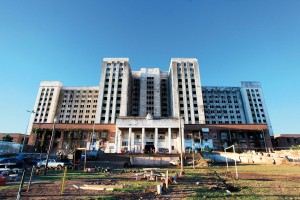
01
L’éléphant blanc, habiter l’inhabituel
Tiphaine Abenia ENSA Toulouse [FR]
El elefante blanco, habiter l’inhabituel
Immense vaisseau hospitalier jamais achevé, «?l’éléphant blanc?» est une structure de béton brut de quatorze étages. Depuis son édification en 1937, il n’a connu d’autres destins que l’attente puis l’abandon par les institutions. Dominant un bidonville au sud de Buenos Aires, il est aujourd’hui habité par une centaine de familles qui ont investi les premiers étages. Cet édifice hors du temps est pour Tiphaine Abenia un terrain d’étude et d’expérimentation.
—
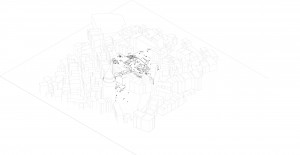
02
Mains à l’œuvre : bienvenue À Galata
Pinar Bozoglan Rotterdam Academy of Architecture and Urban Design [NL]
Galata Cultural Production Center
Le quartier historique de Galata surplombe la Corne d’Or sur les pentes de la rive européenne d’Istanbul. Associant artisanats traditionnels et production artistique contemporaine, le projet de Pinar Bozoglan s’appuie sur les ressources du quartier pour concevoir un espace de médiation et de production culturelle, au service d’une transmission des savoir-faire et de leur visibilité dans la ville. Loin d’une entreprise de patrimonialisation, ce Galata Production Center participe à la réinvention permanente d’Istanbul, entre un patrimoine immatériel fait de petites activités de moins en moins visibles et l’incapacité du monde contemporain à se passer de vitrines.
—
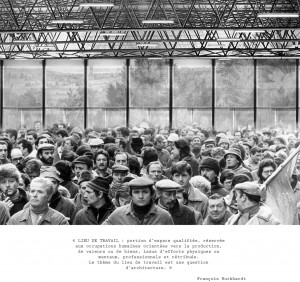
03
Sens au travail : interactions productives
Federico Diodato & Mélanie Simonella ENSA Paris Malaquais [FR]
> Sens au travail
Comment transformer des sites de production dont l’activité originelle se rétracte?? Federico Diodato et Mélanie Simonella étudient l’adaptation d’un site industriel à Sens, en Bourgogne. Cette usine de câbles électriques a subi des plans sociaux et la délocalisation de certaines fonctions de production. Des espaces occupés par des machines sont aujourd’hui susceptibles d’être réinvestis par de nouvelles activités. Le projet réinterroge des séparations dont la pertinence s’érode : entre le bureau et l’atelier, entre l’ingénieur et l’ouvrier, entre la conception et la fabrication.
—
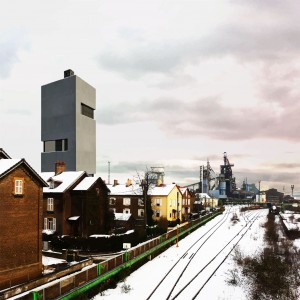
04
Maisons témoins : un récit de la vallée des anges
Maxime Douche ENSA Paris Malaquais [FR]
Récit critique de la vallée des Anges. La maison, métaphore de la vallée de la Fensch.
Au cours des dernières années, les hauts-fourneaux de Florange ou l’aciérie de Grandange ont alimenté l’actualité, cristallisant des images de perte et de conflit social, enfouissant les vies personnelles dans le récit d’une tragédie collective. Mais que sait-on de la vallée de la Fensch dont les noms riment avec «?ange?»?? Maxime Douche invite à une autre mise en récit. Il compose un tableau surprenant de justesse et d’empathie à partir de la maison de six personnages, fictifs mais vraisemblables, isolés mais reliés par une histoire commune, six manières d’habiter la vallée.
—
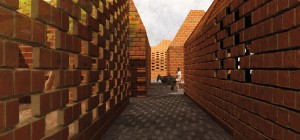
05
Terre burkinabée : de terrains vagues en cultures publiques
Nathalie Giraud & Manon Borie ENSAP Bordeaux [FR]
Les délaissés de Ouagadougou, entre réalisme technique et poétique urbaine
Suite à une première demande de création d’un lieu de lecture par une association locale dans un quartier démuni de Ouagadougou, Nathalie Giraud et Manon Borie ont uni leurs efforts dans la conduite de plusieurs projets au Burkina Faso. À l’origine de ce travail, se pose une réflexion sur les possibilités d’utilisation d’espaces non construits qui sont autant de réserves et de potentiels pour mettre en place des activités partagées, qu’elles soient communautaires, culturelles ou économiques.
—
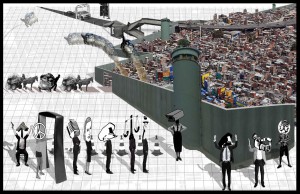
06
Villa miseria : manifeste pour un isolement créatif
Matteo Locci Università digli Studi di Roma Tre [IT]
Laboratorio 31 / mind your own business
La villa 31 est le bidonville le plus ancien et le plus étendu de Buenos Aires, dont les 30 000 habitants sont la cible récurrente d’indignations politiques. Ce travail en forme de manifeste bouscule les idées reçues et conteste le bien-fondé de stratégies publiques vouées à l’échec. Refusant toute forme d’assistance et de dissimulation de la pauvreté, Matteo Locci promeut l’autoreprésentation et l’autodétermination des habitants, comme seuls antidotes aux tentatives de résorption des bidonvilles.
—
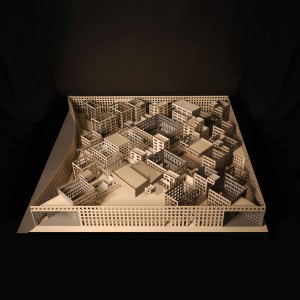
07
Reconstruire et décontracter le Stopera
Donna van Milligen Bielke Academy of Architecture Amsterdam [NL]
Reversed boogie woogie, Design for the Amsterdam City Hall
Projet en forme d’exploration sur un cas d’école, la recomposition de cet îlot intègre deux institutions de la capitale néerlandaise : le Stopera est une contraction de langage pour désigner un bâtiment hybride associant le Stadhuis (l’hôtel de ville) et l’Opera (Opéra et Ballet national). Donna van Milligen Bielke propose de reconstruire cet édifice, inauguré en 1986. Au-delà de la seule articulation des fonctions, elle interroge la complexité d’une architecture qui marque la présence des institutions, réalise de nouvelles connexions et joue la décontraction.
—
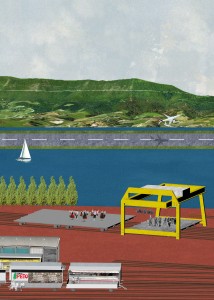
08
Ceci n’est pas une frontière
Lucie Rebeyrol ENSA Paris La Villette [FR]
La ville paysage post-frontière.
Requalifier le faisceau ferroviaire entre Hendaye et Irun
Issu d’une réflexion sur une géographie frontalière – la topographie naturelle, historique et sociale de la baie de Txingudi au Pays basque –, le projet porte sur le devenir d’une plateforme ferroviaire bientôt obsolète à l’interface des gares française et espagnole. Après la mise en place du marché unique et de l’espace Schengen, Lucie Rebeyrol se demande comment aborder un projet architectural et urbain sur une frontière disparue. Que faire de cette infrastructure contournée par le projet de ligne à grande vitesse Paris?-?Madrid??
—
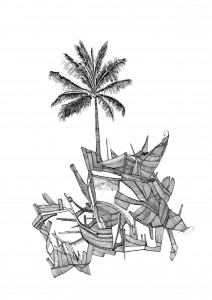
09
De la disparition : regards sur le changement du monde
Adrien Rousseau ENSP de Versailles [FR]
Les paysages de l’inattendu, voyage en territoires de l’imaginaire
La démarche d’Adrien Rousseau procède d’un regard fragmentaire et fragmenté sur le monde et ses changements. De son attrait pour les fictions dessinées, le paysagiste tire un protocole précis d’observations et d’annotations, qui tient à la fois du carnet de voyages et du cabinet de curiosités : sont ici rassemblés huit lieux sur la planète où s’exprime la nature accidentelle du monde. Ces fragments collectés, finalement rassemblés dans un jardin manifeste, nous projette dans une fiction étrangement double, à la fois inquiétante et positive.
—
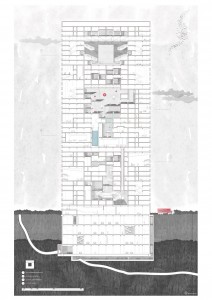
10
Onirique hôtel de Tiraspol : le touriste et l’évadé
Veronica Sereda ENSA Paris Malaquais [FR]
Hôtel Tiraspol, traversée d’une architecture des rumeurs
Objet littéraire par excellence, lieu de rencontres secrètes et d’activités illicites, résidence discrète pour le fugitif et point d’étape pour le voyageur, la figure de l’hôtel est un terreau pour l’imagination. Le projet de fin d’études de Veronica Sereda se pose comme une fiction architecturale autour d’un «?délire géopolitique?» : la Transnistrie est un État de non-droit, minuscule territoire limitrophe ayant déclaré son indépendance après la chute du bloc soviétique. L’hôtel Tiraspol se situe au bord du fleuve Dniestr, au débouché d’un pont faisant office de check point.
—
textes: Emmanuel Redoutey, Juillet 2014
01
The White Elephant: living in an unusual setting
Tiphaine Abenia ENSA Toulouse [FR]
> El elefante blanco: living in an unusual space
A huge unfinished hospital reminiscent of a vast ship, the “White Elephant” is a raw concrete structure with fourteen storeys. Since it was built in 1937, its future was always uncertain and it was eventually abandoned by the institutions concerned. Overlooking a slum in the south of Buenos Aires, it is now inhabited by about a hundred families who have moved into the lower floors. This timeless building provides Tiphaine Abenia with a wealth of opportunities for study and experimentation.
—
02
Focus on handicrafts: welcome to Galata
Pinar Bozoglan Rotterdam Academy of Architecture and Urban Design [NL]
> Galata Cultural Production Center
The historic district of Galata in Istanbul overlooks the Golden Horn on the slopes of the European shore of the Bosphorus. Bringing together traditional craftsmen and contemporary artists, Pinar Bozoglan’s project uses the existing resources of the district to design a centre for cultural mediation and production fostering the transmission of expertise and enhancing the visibility of the craftsmen in the city. Instead of merely focusing on showcasing national heritage, the Galata Production Center contributes to the on-going reinvention of Istanbul, embracing not only an intangible heritage made up of more or less visible crafts, but also the inability of the modern world to do without window displays.
—
03
Productive interactions in Sens
Federico Diodato & Mélanie Simonella ENSA Paris Malaquais [FR]
> Sens at work
How can we transform factories whose initial activity is in decline? Federico Diodato and Mélanie Simonella have explored how to adapt an industrial facility in Sens, Burgundy: an electric cable factory that has suffered from redundancies and the relocation of some of its production units. The areas once occupied by machinery can now be used for new activities. The project challenges separations that are no longer as relevant as they once were: between offices and workshops, between engineers and factory workers, and between design and manufacturing.
—
04
Houses bearing witness: a story from the Valley of Angels
Maxime Douche ENSA Paris Malaquais [FR]
> A critical narrative from the Valley of Angels. The house as a metaphor of the Fensch Valley.
In recent years, the Florange and Grandange foundries have received extensive coverage in the press, crystallising images of loss and social conflict and swamping individual lives in a narrative of collective tragedy. But what do we really know about the Fensch Valley, with its towns whose names rhyme with “ange” [angel]? Maxime Douche invites us to listen to an alternative story. He paints a surprisingly empathetic picture based on the houses of six fictional but believable characters who are isolated but linked by a common history: six ways of living in the valley.
—
05
Burkina Faso: from waste ground to public culture
Nathalie Giraud & Manon Borie ENSAP Bordeaux [FR]
> Waste ground in Ouagadougou: technical realism and urban poetry
Following an initial request from a local association to set up a reading space in a poor district of Ouagadougou, Nathalie Giraud and Manon Borie have joined forces to head up several projects in Burkina Faso. The work is based on an investigation of possible ways to use non-built spaces that provide opportunities to set up community, cultural or commercial activities.
—
06
Villa miseria: a manifesto for creative isolation
Matteo Locci Università digli Studi di Roma Tre [IT]
> Laboratorio 31 / mind your own business
Villa 31 is the oldest and largest slum in Buenos Aires; its 30,000 residents repeatedly spark political indignation. This project, which takes the form of a manifesto, overturns preconceptions and challenges the validity of public strategies that are doomed to failure. Rejecting all forms of assistance and the dissimulation of poverty, Matteo Locci promotes self-representation and self-determination for local residents as the only possible antidote to attempts to reclaim the slums.
07
Reconstructing and relaxing the Stopera
Donna van Milligen Bielke Academy of Architecture Amsterdam [NL]
> Reversed boogie woogie, Design for the Amsterdam City Hall
This project focuses on a case study involving the conversion of a complex housing two Amsterdam institutions: Stopera is a portmanteau term referring to a hybrid building consisting of the Stadhuis (City Hall) and the Opera (Opera and National Ballet). Donna van Milligen Bielke proposes to reconstruct this building, built in 1986. Instead of just focusing on the way its functions are articulated, she explores the complexity of a form of architecture that emphasises the presence of the institutions, produces new interconnections, and aims at creating a more relaxed impression.
—
08
This is not a border
Lucie Rebeyrol ENSA Paris La Villette [FR]
> Post-frontier town and landscape. Converting the railway tracks between Hendaye and Irun.
This project is the result of a study on the geography of border areas, and specifically the natural, historic and social topography of the Bay of Txingudi in the Basque Country. It focuses on the future of a soon obsolete set of railway tracks between the stations on either side of the French-Spanish border. Following the implementation of the single market and the Schengen Area, Lucie Rebeyrol explores how to approach an architecture and planning project for a defunct frontier. What can be done with this infrastructure, soon to be made obsolete by the Paris-Madrid high speed train project?
—
09
The notion of disappearance: perspectives on a changing world
Adrien Rousseau ENSP de Versailles [FR]
> Landscapes of the Unexpected, a Journey into Imaginary Territories
Landscape artist Adrien Rousseau’s approach is based on a fragmentary and fragmented view of the changing world. He uses a precise protocol of observations and annotations –inspired by the graphic novels he loves– that can be compared both to a travel diary and a cabinet of curiosities: here we see eight places on the planet where the accidental nature of the world is expressed. These collected fragments, ultimately brought together in a statement garden, projects us into a strange, dual fiction that is at once unsettling and positive.
—
10
The imaginary Tiraspol Hotel: the Tourist and the Fugitive
Veronica Sereda ENSA Paris Malaquais [FR]
> Tiraspol Hotel: an architecture of rumours
A literary object par excellence, a place for illicit encounters and activities, a discreet home for the fugitive and a departure point for the traveller, the hotel is a powerful source of inspiration. Veronica Sereda’s graduation project takes the form of a fictional architectural narrative focusing on a “geopolitical fantasy”: Transnistria is a lawless land, a tiny territory bordering others that declared its independence after the fall of the Soviet Block. The Tiraspol Hotel is located on the banks of the Dniestr, at one end of a bridge that is used as a checkpoint.
texts: Emmanuel Redoutey, July 2014





